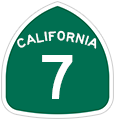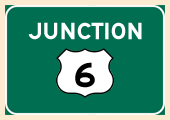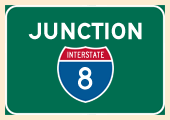California 7 is a short expressway between the Calexico East International Border Crossing and Interstate 8 in the Imperial Valley. It is designed as a fast route between the border crossing and the Interstate Highway System that bypasses Calexico and El Centro.
The State Route 7 designation was previously used in two other instances, both in Southern California: Sepulveda Boulevard was signed as California 7 until it was replaced with Interstate 405 (San Diego Freeway), and the Long Beach Freeway was known as California 7 until it was redesignated as Interstate 710 in the 1980s.
| California 7 north |
|
In the Calexico East Border Station, this is the first reassurance shield for northbound California 7. Photo taken 03/26/06. |
|
Departing from the Calexico East Border Station, this is zero postmile for California 7. A standard Welcome to California with the state flower is posted after the no parking regulatory sign. Photo taken 03/26/06. |
|
The first intersection along northbound California 7 is with Menvielle Road (signed as Carr Road). Turn north on Menvielle Road, then turn west on Carr Road. Carr Road travels west to serve local farms and ranches in this section of Imperial County. The construction of the port of entry, which was completed in the late 1990s, resulted in the realignment of Carr Road to the current configuration. Photo taken 03/26/06. |
|
Continue straight ahead through the Menvielle Road/Carr Road intersection to follow California 7 north to California 98 and Interstate 8. To the city of Calexico, follow California 7 north to California 98 east. Photo taken 03/26/06. |
|
Northbound California 7 reaches the intersection with Menvielle Road. After passing the Carr Road intersection, Menvielle Road travels north to California 98 on an alignment parallel to California 7. Photo taken 03/26/06. |
|
Another reassurance sign for California 7 is posted after the Menvielle Road intersection. In the distance, the interchange with Nina Lee Road comes into view. Photo taken 03/26/06. |
|
Now crossing a drainage ditch, California 7 north prepares to cross over and then merge with the two northbound lanes of commercial traffic coming from the commercial port of entry. The northbound route will turn north to join the trucks via a loop ramp (ahead). Photo taken 03/26/06. |
|
The left lane continues east onto Nina Lee Road, while the two right lanes transition onto a loop ramp that connects with the northbound truck lanes from the commercial port of entry. Photo taken 03/26/06. |
|
The transition onto northbound California 7 is a two-lane loop ramp. Photo taken 03/26/06. |
|
Now on the loop ramp, a reassurance shield for California 7 north is posted. This is one of the rare examples of reassurance signage on transition ramps in California. Photo taken 03/26/06. |
|
Northbound California 7 passes under itself (Nina Lee Road overcrossing) and proceeds north toward California 98 and Interstate 8. Photo taken 03/26/06. |
|
This mileage sign provides the distance to California 98 (0.75 mile) and Interstate 8 (6.25 miles). The entire route to Interstate 8 is expressway, with only two traffic signals (one for Maggio Road and the other for California 98) between here and the Interstate Highway System. California 7 was constructed with the intent of providing a direct connection from Mexico to Interstate 8 without using the local street network or rural farm-to-market highways. Photo taken 03/26/06. |
|
Maggio Road provides a connection to Rood Road to the east and with motorist services (gas and food) at the southeast corner of the intersection. Photo taken 03/26/06. |
|
Northbound California 7 meets Maggio Road at this traffic signal. Photo taken 03/26/06. |
|
Another mileage sign for California 98 (0.25 mile) and Interstate 8 (5.75 miles) is posted after the Maggio Road intersection. The traffic signal for California 98 comes into view in the distance. Photo taken 01/15/07. |
|
Now approaching California 98, a right turn follows California 98 east to Interstate 8 at Midway Well. To Yuma, follow Interstate 8 east through the Imperial (Algodones) Sand Dunes and over the Colorado River into Arizona. Looking west, it is about eight miles east to the border city of Calexico, which is located just north of Mexicali, Baja California, Mexico. Photo taken 01/15/07. |
|
Northbound California 7 reaches the junction with California 98. Between 1999 and 2005, this was the northern terminus of a very short state route. However, with the recent opening of the concrete, four-lane expressway, California 7 now travels north another 5.50 miles to east-west Interstate 8. Photo taken 01/15/07. |
|
Continuing north, California 7 leaves the 1999 expressway and enters the 2005 expressway. The pavement shifts from asphalt to concrete. The entire route is a four-lane, divided expressway with concrete paving. Photo taken 01/27/06. |
|
The interchange with Interstate 8 is a little more than four miles north of the California 98 intersection. Photo taken 01/27/06. |
|
While planned as a freeway initially, California 7 was constructed as an expressway. Tolls were briefly considered to fund the construction of the route, but that changed when state and local funding became available to link the Calexico East Border Crossing with Interstate 8. Photo taken 01/27/06. |
|
The high tension power lines that cross California 7 are 500kV lines that interconnect from Arizona (Palo Verde Nuclear Power Plant) west to the San Miguel Power Station southeast of San Diego near Bonita. This powerline is known as the Southwest Powerlink. Photo taken 01/27/06. |
|
The design features of the California 7 expressway north of California 98 include concrete travel lanes and concrete shoulders, which is not a common feature of most California expressways. Photo taken 01/27/06. |
|
The only access points along California 7 are intersections, such as this one at Heber Road. Heber Road provides local farm to market access. Photo taken 01/27/06. |
|
Another California 7 reassurance shield is posted after the Heber Road intersection. The verdant fields east of the expressway are part of the winter growing season in the eastern Imperial Valley. Photo taken 01/27/06. |
|
As a new road, California 7 was lightly traveled on this day. Photo taken 01/27/06. |
|
The next intersection along northbound California 7 is McCabe Road, which parallels Heber Road and also provides farm to market access. Photo taken 01/27/06. |
|
After McCabe Road, it is only another mile and a half to Interstate 8. Photo taken 01/27/06. |
|
Interstate 8 is the primary access point for trucks entering the United States to the rest of the country's freeway network. Connections with California 111 north leads motorists through the Imperial Valley to Brawley, the Salton Sea, Indio and I-10. Photo taken 01/27/06. |
|
End expressway signs are posted on northbound California 7 as the highway approaches Interstate 8. The transition ramps to Interstate 8 are not especially designed for high speed travel, so reduce speeds. Photo taken 01/27/06. |
|
To avoid conflict with the Interstate 8 interchange, California 7 is grade separated from Hunt Road (which changes into Chick Road a few miles west of here). Photo taken 01/27/06. |
|
Another set of end expressway signs are posted as northbound California 7 approaches Interstate 8. Photo taken 01/27/06. |
|
A new right lane offers the connection to Interstate 8 east to Yuma, while a left turn will make the connection to westbound Interstate 8 en route to El Centro and San Diego. Photo taken 01/27/06. |
|
Northbound California 7 meets Interstate 8 at this interchange, which is not designed for high speeds. Watch for traffic turning onto Orchard Road from the eastbound Interstate 8 off-ramp. Imperial County S-32 (Orchard Road) continues north of Interstate 8 into the city of Holtville. Holtville is only a few miles north of Interstate 8 along California 115 and Old U.S. 80. Photo taken 01/27/06. |
|
The next exit is a loop ramp that connects northbound California 7 with westbound Interstate 8, which travels to El Centro and San Diego. Photo taken 03/26/06. |
|
While the right lane exits only onto Interstate 8 westbound, the left lane continues north onto Imperial County S-32 (Orchard Road). Photo taken 03/26/06. |
|
Although there is no end California 7 at the northern end, the state highway ends as the expressway transitions onto Imperial County S-32 north. Imperial County S-32 (Orchard Road) travels north to Holtville, where it meets California 115 and Old U.S. 80. North of Holtville, Imperial County S-32 continues north via Holt Road and Butters Road, ending at Imperial County S-26 (Rutherford Road) east of Wiest. Photo taken 03/26/06. |
|
At the pavement change, California 7 transitions onto Imperial County S-32 (Orchard Road). Plans call for California 7 to continue north to Holtville, where it would meet California 115 (Old U.S. 80), but it is unclear whether that extension would be constructed. Officially, California 7 ends at Interstate 8 (as of April 2006), and there are no provisions in the State of California Streets and Highways Code to extend it north to Holtville. Photo taken 03/26/06. |
| California 7 south |
|
Leaving the Interstate 8 interchange, this is the first reassurance shield for California 7 south. California 7 is grade separated from Hunt Road (which changes into Chick Road a few miles west of here). Imperial Irrigation District power lines cross California 7 south of the overpass. Photo taken 01/15/07. |
|
California 7 is a four-lane, divided concrete expressway with intersections spaced about a mile apart. The first intersection is with McCabe Road, followed by Heber Road. Photo taken 01/15/07. |
|
Southbound California 7 meets Heber Road at this intersection. Through traffic on the expressway does not stop, and there are turn lanes for all movements. Photo taken 01/15/07. |
|
This California 7 shield is posted after the Heber Road intersection. Photo taken 01/15/07. |
|
|
The Southwest Powerlink, a major 500kV power line, passes over California 7. This power line extends from the Palo Verde Nuclear Generating Station in Arizona west to San Diego, with a stop at the massive Imperial Valley Substation in the Yuha Desert. Photos taken 01/15/07. |
|
The next major intersection on California 7 south is with California 98, the east-west highway that parallels the United States-Mexico border and serves the city of Calexico. This intersection is signalized, so traffic should slow down in advance of it. Photo taken 01/15/07. |
|
To the east, California 98 follows Cole Road to Interstate 8 Exit 143. From there, Interstate 8 crosses the Algodones Dunes to Winterhaven and Yuma. There are no services along California 98 east until Interstate 8 meets Sidewinder Road at Exit 164 (Felicity). To the west is Calexico. Motorist services are available in Calexico, and gas and food are available at the border crossing by continuing south on California 7. Photo taken 01/15/07. |
|
Continue south on California 7 to the Calexico East Border Crossing (Port of Entry). Known as "Garita Numero Dos" in Mexicali, Baja California Norte, Mexico, the border crossing is open from 6:00 a.m. to 10:00 p.m. daily. Trucks are permitted to cross here, but they may not cross at California 111 at the main Calexico border crossing. Photo taken 01/15/07. |
|
Southbound California 7 meets California 98 at this signalized intersection. Photo taken 01/15/07. |
|
This reassurance shield for southbound California 7 is posted after the California 98 intersection east of Calexico. Photo taken 03/26/06. |
|
Mexican law prohibits visitors from carrying firearms, and this sign advises travelers entering Mexico not to bring guns or ammunition into the country. Photo taken 03/26/06. |
|
The next traffic signal along southbound is with Maggio Road. Motorist services, such as food and gas, are available at the southeastern corner of this intersection. While the sign says this is the last U.S. Exit, that might be referring to the split between commercial and private vehicles (see interchange in the background). Maggio Road connects to north-south Rood Road to the east. Photo taken 03/26/06. |
|
While the left lane turns onto Maggio Road, southbound California 7 widens to three lanes. Of the three main lanes, the right two lanes are for cars, while the two left lanes are for trucks and commercial vehicles. Photo taken 03/26/06. |
|
At this somewhat odd interchange, southbound California 7 exits from itself, since only trucks may use the left two lanes. These two lanes lead to the commercial port of entry and the international border with Mexico. The mainline of California 7, which is open to passenger vehicles only, exits to the right, but signage of California 7 continues on the passenger car lanes. Photo taken 03/26/06. |
|
The transition of southbound California 7 onto Nina Lee Road is the "last U.S. exit." All trucks must use the left lanes to the commercial port of entry, while passenger cars must use the right lanes to transition onto Nina Lee Road. For trucks, there is no return to the United States after passing under this bridge. Photo taken 03/26/06. |
|
While signed as "To Carr Road," the road that connects directly to California 7 is Nina Lee Road. To Carr Road, turn right onto Nina Lee Road, then make another right at Carr Road. Looking to the east , Nina Lee Road offers a connection back onto northbound California 7. Photo taken 03/26/06. |
|
|
|
Still on southbound California 7, these shields point to both directions of California 7: north back to California 98 and Interstate 8 and south to the international border with Mexico and the port of entry for automobiles. Photos taken 03/26/06 and 07/24/99. |
|
After turning right, Nina Lee Road becomes southbound California 7. The traffic signal for the Carr Road intersection comes into view as the highway passes over a drainage ditch. Soon thereafter, southbound California 7 reaches Menvielle Road (Carr Road). Turn north on Menvielle Road, then turn west on Carr Road. Carr Road travels west to serve local farms and ranches in this section of Imperial County. The construction of the port of entry, which was completed in the late 1990s, resulted in the realignment of Carr Road to the current configuration. Photo taken 03/26/06. |
|
The intersection with Menvielle Road is the final traffic signal along southbound California 7. After passing the Carr Road intersection, Menvielle Road travels north to California 98 on an alignment parallel to California 7. Photo taken 03/26/06. |
|
The last chance to turn around before entering Mexico is at the "Last U-Turn." Photo taken 03/26/06. |
|
Southbound California 7 and state maintenance end at this point, just prior to the last U-Turn. A zero postmile is located in the median next to the left lane. The port of entry lies ahead. Photo taken 03/26/06. |
|
The Calexico East U.S. Border Station is open from 6:00 a.m. to 10:00 p.m. The two main lanes continue south into the border station, while the final U-turn is just ahead. Photo taken 03/26/06. |
|
After this fence, travelers will pass through the border station and find themselves in the state of Baja California in Mexico. A left turn here returns travelers to northbound California 7, on their way back toward California 98. After crossing into Mexico, the state road leading from the border station eventually connect with Mexico Federal Route 2. southeast of Mexicali, the capital of the state of Baja California. Follow the signs south of the border to tourist destinations such as San Felipe on the Sea of Cortez (Gulf of California). Photo taken 03/26/06. |
| California 7 scenes |
| California 7 in 1999, Prior to the Extension North to Interstate 8 |
|
This photo shows the former "End California 7" shield assembly that used to exist along northbound California 7 at its intersection with California 98. This end was temporary pending construction of the direct California 7 connection to Interstate 8. California 7 is a relatively new route, commissioned around 1994, that provides access to a new Port of Entry between Mexico and California in the Imperial Valley. Since it parallels California 111, it provides relief to that route and to California 86. Only the segment between the border and California 98 has been constructed (to expressway standards). The remainder of the route was constructed between California 98 and Interstate 8 in 2005. Due to an early lack of funding for this new segment, it was briefly considered for construction as a toll road. However, funding was identified from elsewhere, and the highway opened as a free expressway. Portions of the new alignment of California 7 are located along former Orchard Road. The existing Orchard Road interchange was upgraded to handle expressway traffic. Photo taken 07/24/99. |
|
At the former northern end of California 7, this signage is in place for California 98. Note the indicator for Interstate 8. Photo taken 07/24/99. |
Page Updated September 30, 2012.







































































